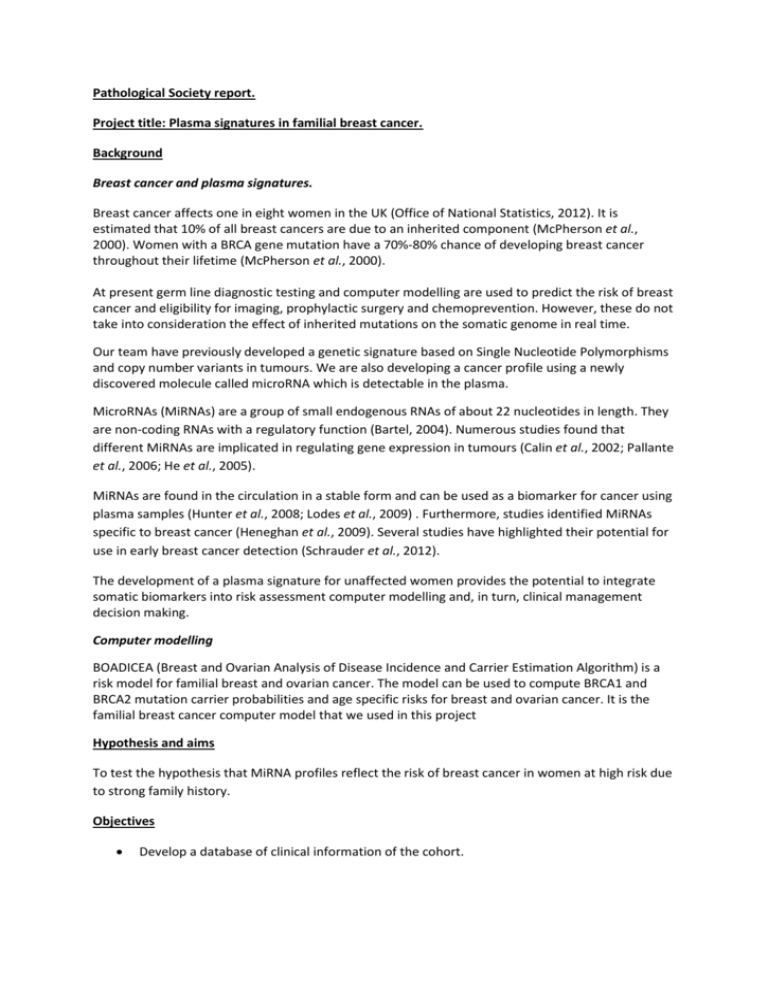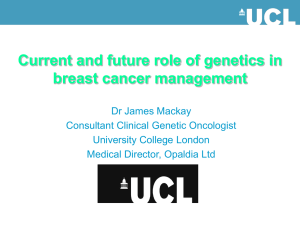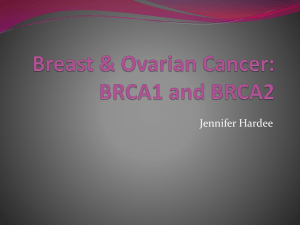Plasma Signatures in familial breast cancer
advertisement

Pathological Society report. Project title: Plasma signatures in familial breast cancer. Background Breast cancer and plasma signatures. Breast cancer affects one in eight women in the UK (Office of National Statistics, 2012). It is estimated that 10% of all breast cancers are due to an inherited component (McPherson et al., 2000). Women with a BRCA gene mutation have a 70%-80% chance of developing breast cancer throughout their lifetime (McPherson et al., 2000). At present germ line diagnostic testing and computer modelling are used to predict the risk of breast cancer and eligibility for imaging, prophylactic surgery and chemoprevention. However, these do not take into consideration the effect of inherited mutations on the somatic genome in real time. Our team have previously developed a genetic signature based on Single Nucleotide Polymorphisms and copy number variants in tumours. We are also developing a cancer profile using a newly discovered molecule called microRNA which is detectable in the plasma. MicroRNAs (MiRNAs) are a group of small endogenous RNAs of about 22 nucleotides in length. They are non-coding RNAs with a regulatory function (Bartel, 2004). Numerous studies found that different MiRNAs are implicated in regulating gene expression in tumours (Calin et al., 2002; Pallante et al., 2006; He et al., 2005). MiRNAs are found in the circulation in a stable form and can be used as a biomarker for cancer using plasma samples (Hunter et al., 2008; Lodes et al., 2009) . Furthermore, studies identified MiRNAs specific to breast cancer (Heneghan et al., 2009). Several studies have highlighted their potential for use in early breast cancer detection (Schrauder et al., 2012). The development of a plasma signature for unaffected women provides the potential to integrate somatic biomarkers into risk assessment computer modelling and, in turn, clinical management decision making. Computer modelling BOADICEA (Breast and Ovarian Analysis of Disease Incidence and Carrier Estimation Algorithm) is a risk model for familial breast and ovarian cancer. The model can be used to compute BRCA1 and BRCA2 mutation carrier probabilities and age specific risks for breast and ovarian cancer. It is the familial breast cancer computer model that we used in this project Hypothesis and aims To test the hypothesis that MiRNA profiles reflect the risk of breast cancer in women at high risk due to strong family history. Objectives Develop a database of clinical information of the cohort. Risk assess the cohort using BOADICEA, looking at 5 year, 10 year and lifetime breast cancer risks. Assess whether these risk assessments reflect the known BRCA status of these patients. Perform an analysis of the candidate MiRNAs in part of the cohort. Relate MiRNA data to the breast cancer risk. Methods In total, 119 patients were recruited for the study prior to the commencement of this BSc project. All individuals gave written informed consent prior to participation. MicroRNA extraction and analysis MicroRNA was extracted from the blood samples of study participants by staff members at the Cancer Studies and Molecular Medicine (CSMM) department. This was followed by reverse transcription and pre-amplification steps on all samples in order to carry out real-time PCR. MiRNAs were selected using a candidate approach. Candidates were picked based on a threefold increase in relative expression in breast cancer patients when compared to healthy controls using commercially available MiRNA assays. The microRNA candidate selection was performed by Dr. Elshaw as part of other on-going studies in the research group. Thirteen different Candidate MiRNA assays were picked by CSMM staff. They were kept unidentified at their request. One set was assigned letters A , B, C, and D respectively and another set was assigned numbers 1 to 9 respectively. They were all Taqman MiRNA assays (Life Technologies). Expression of different MiRNA in the samples was measured by real time quantitative PCR by obtaining the Cycle threshold (Ct) values for each sample. The Ct values were normalised against an endogenous control (U6). The Ct value of the U6 reaction was subtracted from the Ct value of each individual MiRNA reaction to generate a delta Ct value for each MiRNA, which represents the relative expression of that particular MiRNA. BOADICEA risk assessment software for breast cancer All participants were risk assessed using the BOADICEA web application. A family pedigree was drawn for all the study participants. The 5 year, 10 year and lifetime risks of breast cancer were calculated for all patients, with the lifetime risk being risk by age of 80. Data processing The data produced by the real-time PCR reactions and BOADICEA calculations were analysed using Microsoft Excel and two other software packages as follows: Kruskal-Wallis one-way ANOVA (Analysis of Variance) and Dunn’s tests to compare the BOADICEA 5 year, 10 year and lifetime risk of breast cancer of study subjects with a known BRCA mutation status. Kruskal-Wallis one-way ANOVA and Dunn’s tests to compare delta Ct values of different categories of patients on two subsets of the cohort. Partial correlations (correlations controlling for age) between the 5 year, 10 year and lifetime breast cancer risks and delta Ct values for individual MiRNAs. Results The patients were grouped according to their risk of breast cancer due to their BRCA mutation status and history of breast cancer. Table 1 describes the categories of study participants used in this study. Category Description BRCA1 Affected Patients carrying a BRCA1 mutation affected by breast or ovarian cancer, postoperative blood sample obtained Participant carrying a BRCA1 mutation not affected by breast cancer Participant from a known BRCA family, but does not carry a BRCA mutation. Does not have breast cancer Patients carrying a BRCA2 mutation affected by breast or ovarian cancer Participant carrying a BRCA2 mutation not affected by breast cancer Participant from a known BRCA family, but does not carry a BRCA mutation. Does not have breast cancer Patients affected by breast cancer but who were found not to have a BRCA1 or BRCA2 mutation. No family history of BRCA mutations. Participant who were found not to have a pathological BRCA1 or BRCA2. They are not affected by breast cancer. No family history of BRCA mutations. Participants who have not undergone genetic testing for BRCA mutations. BRCA1 Carrier BRCA1 Negative Control BRCA2 Affected BRCA2 Carrier BRCA2 Negative Control BRCA Uninformative Cancer Affected BRCA Uninformative Cancer Unaffected Untested Total Number of patients in category 12 16 12 9 7 7 25 1 30 119 Table 1. Categories of study participants. The ‘Untested’ category in Table 1 was further divided into the following subcategories (see Table 2). Subcategory Description Untested Family, Cancer Unaffected. Participant and their family have not undergone genetic testing for BRCA mutations. Patient unaffected by breast cancer Patient and their family have not undergone genetic testing for BRCA mutations. Patient affected by breast cancer Patient has not been tested for BRCA mutations. One of their relative has undergone testing with an uninformative result (see uninformative category). Patient is unaffected by cancer Patient has not been tested for BRCA mutations. There is a history of a BRCA1 mutation in the family. Patient is unaffected by cancer. Patient has not been tested for BRCA mutations. There is a history of a BRCA2 mutation in the family. Patient is unaffected by cancer. Untested Family Cancer Affected Untested Patient, Uninformative relative. Cancer Unaffected Untested patient, BRCA1 in family. Cancer unaffected Untested patient, BRCA2 in family. Cancer unaffected Total Table 2. ‘Untested’ subcategories. Number of patients in subcategory 9 2 16 2 1 30 Summary of results BOADICEA provides a significantly higher breast cancer risk calculation for individuals with a BRCA mutation. This was seen in the study cohort across 5 year, 10 year and lifetime risk estimation (see Figure 1 below). B O A D IC E A S C O R E S 1 .0 L ife tim e b re a s t c a n c e r r is k Key BRCA1 No Ca = BRCA1 Carrier BRCA1 Ca = BRCA1 Affected BRCA2 No Ca = BRCA2 Carrier BRCA2 Ca = BRCA2 Affected BRCA1 Neg. Cont. = BRCA1 Negative Control BRCA2 Neg. Cont. = BRCA2 Negative Control Uninformative Ca = BRCA Uninformative Cancer Unaffected 0 .8 0 .6 0 .4 0 .2 C e ti v C . in n U B R C A 2 fo N rm e a g . g e N 1 A C R B a t. n o n o C 2 A C R B A R C t. a C a C o N 2 C R B B B R C A 1 N A o 1 C C a a 0 .0 C a te g o ry Figure 1 Box and whisker plot of Lifetime BOADICEA breast cancer risk of study participants in their respective categories. Interpreting box and whisker plots: The box extends from the 25th to the 75th percentile. The whiskers extend from the minimum to the maximum value. The line within the box represents the median value. BRCA1 and BRCA2 breast cancer affected individuals, BRCA mutation carriers and negative controls all have significantly lower Ct values compared to healthy controls. However, there was no statistical difference between BRCA cancer affected individuals, BRCA carriers, BRCA negative controls and untested participants unaffected by cancer. This was replicated using MicroRNAs A – D (p-values <0.01 to <0.001 depending on category). Figure 2 shows the real-time PCR results of the MicroRNA A assay. M ic ro R N A 'A ' 0 D e lt a C t -5 -1 0 -1 5 H U n te s te d e F a a lt h m y il B y R c o C C n a A tr n 2 o c e N B l r e R U g C a n ti A a v 1 ff e N . C e o g n a tr ti v o e l C o B n R tr C o A l 2 C B a R rr C ie A r 1 B C R a C rr A ie 2 r A B ff R e C c A te 1 d A ff e c te d C a te g o ry Figure 2 Box and whisker plot of delta Ct values of MicroRNA ‘A’ of healthy controls and study participants within their respective categories. Nine different MiRNA assays (MicroRNA assays 1-9) failed to find a statistical difference among the BRCA untested patients and BRCA uninformative individuals. However, there were several outliers identified in several groups. Figure 3 shows the real-time PCR results of MicroRNA 1 assay. M iR 1 Key 20 Untested pt. Unif rel Ca unaf = Untested patient, uninformative relative cancer unaffected 15 Untested Ca unaffected = Untested cancer unaffected D e lta C T 10 5 Untested BRCA1 in family.unaff = Untested patient, BRCA1 in family cancer unaffected 0 Untested BRCA2 in family.unaff = Untested patient, BRCA2 in family cancer unaffected ff ff a n n .u .u y y il il m m fa in 2 1 A A C C R R B B d te s s U n te te n U fa a in C d s te n U d te s te n a d te d e ff a ff a n u a te C d te s n te c te e u C l re f in n U t. p U d te c n c e a ff a n u r e c n a c e v ti U n U a td d te c e ff a r e c n a c e v ti a a rm rm fo fo in in n U f -5 C a te g o ry Figure 3 Scatter graph of delta Ct values of MicroRNA ‘1’ of study participants within their respective categories. Partial correlations between the same 4 candidate MiRNA assays (assays A-D) and 5 year, 10 year and lifetime BOADICEA breast cancer risk scores were not found to be of statistical significance (see Figure 4). Figure 4 A partial correlation controlling for age between BOADICIA Lifetime breast cancer risk scores and MicroRNA ‘A’ Delta Ct (Untested fam. Cancer unaf. = untested family, cancer unaffected). Discussion BOADICEA as a breast cancer risk assessment tool Based on our cohort, BOADICEA provided significantly higher 5 year, 10 year and lifetime breast cancer risk estimations for individuals who have a BRCA mutation compared to individuals without a BRCA mutation. This has been replicated in other studies (Antoniou et al., 2008). However, it could not distinguish between groups who have different risks of developing breast cancer based on their family history in the absence of a BRCA mutation. MicroRNA assays The delta Ct values based on 4 different assays were statistically significantly lower in participants who are BRCA1 or BRCA2 cancer affected, BRCA mutation carriers or BRCA negative controls compared to healthy individuals. This reflects the increased expression of these 4 MiRNA molecules in the plasma of these patients. These 4 MiRNA molecules were selected as candidate assays for this study based on the fact that they are raised in breast cancer patients compared to controls. We show here that they are raised in groups who have not developed cancer but are at an increased risk of developing breast cancer due to a family history of breast cancer, a personal history of breast cancer or a BRCA mutation. However, the relative expression of MicroRNAs A - D did not significantly differ between the BRCA1 affected, BRCA1 mutation carriers and the BRCA1 negative controls and the same applies for the BRCA2 counterparts of these categories. One could hypothesise that since all the blood samples in this study were collected post-surgery from breast cancer affected females, the BRCA affected and the BRCA mutation carriers would not necessarily show any changes as there is increasing evidence in the literature that the relative expression of certain MicroRNAs is reduced in blood post-surgically (Tsujiura et al., 2010). Explaining why the BRCA negative controls had a similar MicroRNA profile to these groups is more difficult. Two factors can account for the similarity of these profiles. The first one being the fact that 59 out of 119 participants have at least one relative within the study. This was not accounted for in the methodology of the statistical analyses. On the other hand, evidence from a recent study suggests that individuals who test negative for a BRCA mutation present in their family, i.e. BRCA negative controls, may have a significantly higher risk of breast cancer compared to the general population. So, the similarity of the MicroRNA profiles of BRCA negative controls to the profiles of BRCA mutation carriers may actually indicate the fact that the BRCA negative controls in our cohort have a high breast cancer risk profile that is more similar to BRCA mutation carriers than it is to the general population. (Vos et al., 2013). The 9 other MicroRNA assays (MicroRNA assays 1-9) did not separate the different groups of BRCA uninformative and BRCA untested individuals. However, finding a statistically significant difference between the groups may have been too hard to achieve given the limited number of individuals in each group. On the other hand, as mentioned earlier, there were a number of ‘outliers’ in several groups. These outliers may be indicating that these individuals possibly have a higher risk of breast cancer compared to the rest of their group. Partial correlations The age-adjusted correlations carried out between MiRNA profiles and BOADICEA risk scores were not statistically significant for any of the MiRNA assays. This could be due to the fact that there were several untested individuals for BRCA mutations. As mentioned earlier, BOADICEA was unable to distinguish between groups when there are no BRCA mutations present. Conclusions The relative expression of MicroRNA molecules A - D were all found to be significantly elevated in participants with a known BRCA mutation status with a personal or family history of a BRCA mutation compared to a control group with no personal or family history of cancer or BRCA mutation. However, no statistically significant difference was found among the categories mentioned above. The relative expression of other MicroRNA molecules 1-9 did not show any statistically significant increase in other categories of the cohort compared to healthy controls. Further studies are required to draw a definitive conclusion on the use of these MicroRNA assays in breast cancer risk prediction. The BOADICEA breast cancer risk assessments showed that BOADICEA provided significantly increased breast cancer risk estimates for individuals with a known BRCA mutation status who have a personal or family history of a BRCA mutation compared to participants who were untested for BRCA mutations or had no personal or family history of a BRCA mutation. We can conclude that BOADICEA is of better value in families where a BRCA mutation has been identified. Correlations between 5 year, 10 year and lifetime BOADICEA breast cancer risks and 4 different MicroRNA assays were not statistically significant which lead us to the conclusion that the BOADICEA breast cancer risk estimates and the relative expression of these 4 MicroRNAs in plasma are not related. Therefore, the MicroRNA profiles do not reflect the risk of breast cancer in women at high risk due to strong family history as calculated by the BOADICEA. The inclusion of more participants in the study would allow more statistically robust tests to be employed. Follow up of the current cohort is recommended and observing changes within groups with regards to breast cancer status would be very useful as certain changes could potentially be linked to certain MiRNA profiles. Further research into the classification of certain groups of MiRNA assays to ascertain which MiRNA profiles are associated with the development of new breast cancer in previously cancer free patients within the cohort. References Antoniou, A.C., Cunningham, A.P., Peto, J., Evans, D.G., Lalloo, F., Narod, S.A., Risch, H.A., Eyfjord, J.E., Hopper, J.L., Southey, M.C., Olsson, H., Johannsson, O., Borg, A., Passini, B., Radice, P., Manoukian, S., Eccles, D.M., Tang, N., Olah, E., Anton-Culver, H., Warner, E., Lubinski, J., Gronwald, J., Gorski, B., Tryggvadottir, L., Syrjakoski, K., Kallioniemi, O., Eerola, H., Nevanlinna, H., Pharoah, P.D.P., Easton, D.F., 2008. The BOADICEA model of genetic susceptibility to breast and ovarian cancers: updates and extensions. British Journal of Cancer. 98, 1457-1466. Bartel, D.P., 2004. MicroRNAs: Genomics, Biogenesis, Mechanism, and Function. Cell. 116, 281-297. Calin, G.A., Dumitru, C.D., Shimizu, M., Bichi, R., Zupo, S., Noch, E., Aldler, H., Rattan, S., Keating, M., Rai, K., 2002. Frequent deletions and down-regulation of micro-RNA genes miR15 and miR16 at 13q14 in chronic lymphocytic leukemia. Proceedings of the National Academy of Sciences. 99, 1552415529. He, L., Thomson, J.M., Hemann, M.T., Hernando-Monge, E., Mu, D., Goodson, S., Powers, S., CordonCardo, C., Lowe, S.W., Hannon, G.J., Hammond, S.M., 2005. A microRNA polycistron as a potential human oncogene. Nature. 435, 828-833. Heneghan, H., Miller, N., Lowery, A., Sweeney, K., Kerin, M., 2009. MicroRNAs as novel biomarkers for breast cancer. Journal of Oncology. 2010, . Hunter, M.P., Ismail, N., Zhang, X., Aguda, B.D., Lee, E.J., Yu, L., Xiao, T., Schafer, J., Lee, M.T., Schmittgen, T.D., 2008. Detection of microRNA expression in human peripheral blood microvesicles. PloS One. 3, e3694. Lodes, M.J., Caraballo, M., Suciu, D., Munro, S., Kumar, A., Anderson, B., 2009. Detection of cancer with serum miRNAs on an oligonucleotide microarray. PLoS One. 4, e6229. McPherson, K., Steel, C.M., Dixon, J.M., 2000. ABC of breast diseases. Breast cancer-epidemiology, risk factors, and genetics. BMJ (Clinical Research Ed.). 321, 624-628. Office of National Statistics, 2012. Breast cancer: incidence, mortality and survival, 2010. [online]. Available at: http://www.ons.gov.uk/ons/rel/cancer-unit/breast-cancer-in-england/2010/sum1.html [accessed 6/05 2013]. Pallante, P., Visone, R., Ferracin, M., Ferraro, A., Berlingieri, M., Troncone, G., Chiappetta, G., Liu, C., Santoro, M., Negrini, M., 2006. MicroRNA deregulation in human thyroid papillary carcinomas. Endocrine-Related Cancer. 13, 497-508. Schrauder, M.G., Strick, R., Schulz-Wendtland, R., Strissel, P.L., Kahmann, L., Loehberg, C.R., Lux, M.P., Jud, S.M., Hartmann, A., Hein, A., 2012. Circulating micro-RNAs as potential blood-based markers for early stage breast cancer detection. PLoS One. 7, e29770. Tsujiura, M., Ichikawa, D., Komatsu, S., Shiozaki, A., Takeshita, H., Kosuga, T., Konishi, H., Morimura, R., Deguchi, K., Fujiwara, H., 2010. Circulating microRNAs in plasma of patients with gastric cancers. British Journal of Cancer. 102, 1174-1179. Vos, J.R., de Bock, G.H., Teixeira, N., van der Kolk, Dorina M, Jansen, L., Mourits, M.J., Oosterwijk, J.C., 2013. Proven non-carriers in BRCA families have an earlier age of onset of breast cancer. European Journal of Cancer.





